What is Occupational Health?
Key message: Adapt the work to the person and each person to their work.
What are the aims of occupational health?
The aims of occupational health have been defined by the ILO (International Labour Organisation) and the WHO in 1950 and updated as follows by the ILO/WHO Joint Committee on Occupational Health in 1995:
"Occupational health should aim at the promotion and maintenance of the highest degree of physical, mental and social well-being of workers in all occupations; the prevention amongst workers of departures from health caused by their working conditions; the protection of workers in their employment from risks resulting from factors adverse to health; the placing and maintenance of the worker in an occupational environment adapted to his physiological and psychological capabilities and; to summarize: the adaptation of work to man and of each man to his job." (www.icohweb.org/site/multimedia/code_of_ethics/code-of-ethics-en.pdf, 13.06.24, p.14)
The WHO website on occupational health says:
"The science and practice of occupational health involves several disciplines, such as occupational medicine, nursing, ergonomics, psychology, hygiene, safety and other." (www.who.int/health-topics/occupational-health, 13.06.24)
The WHO website on healthy workpolaces says:
"Healthy, safe and resilient workplaces are places where all people can perform their jobs:
- without getting sick or injured because of their work,
- with opportunities to enhance their physical and mental health and social wellbeing,
- while preserving harmony with nature and being protected in case of disaster in the community."
Occupational Health has four categories:
- Physical Health and Safety (no physical harm)
- Mental Health (no psychological harm)
- Worksite Health Promotion (increase healt resources)
- Environnement and Community (no harm to and from the environment and the community around the company)
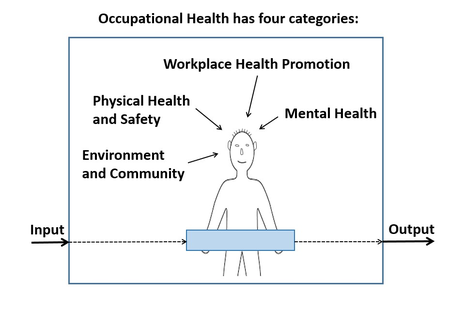
The WHO calls the four categories: Physical Work Environment - Psychosocial Work Environment - Personal Health Resources - Enterprise Community Involvement. (https://iris.who.int/bitstream/handle/10665/44307/9789241599313_eng.pdf?sequence=1, 13.06.24, p. 13)
What Occupational Health Models exist?
There are several models of occupational health:
- The "Job Demands-Control Model" (by Karasek)
- The "Job Demands-Resources Model"
- The "Workload-Strain Model"
From these models I derive my representation of the "Workload-Strain Model" (Rohmert, W., & Rutenfranz, J. (1975). Arbeitswissenschaftliche Beurteilung der Belastung und Beanspruchung an unterschiedlichen industriellen Arbeitsplätzen. Der Bundesminister für Arbeit und Sozialordnung):
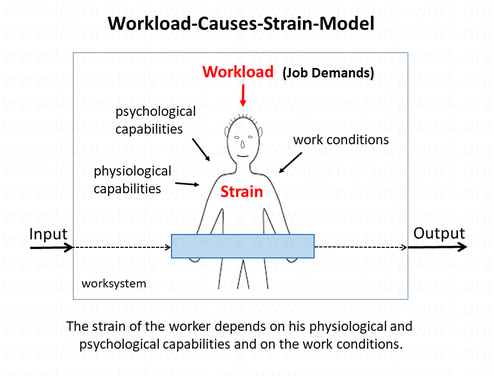
"The workload-strain model described by Rohmert and Rutenfranz as early as 1975 follows the approach that a large number of external stimuli [influences, factors] affect people and, depending on the individual resources, lead to short or long-term strain consequences [effects on people]. ... In this context, it depends on the quality, intensity and duration of the workload as well as the individual personality characteristics of the person and their coping skills and physical constitution." (Rusch, S. (2019). Stressmanagement. Springer, p. 33)
Rohmert and Rutenfranz defined workload as "objective", i.e. independent of the person concerned. However, workload also depends on how a person performs a task.
"Individuals are often expected to perform complex tasks involving physical and mental demands, particularly with the ongoing implementation of technology. ... Workload is determined by the interaction of the task demands, the circumstances under which it is performed, and the skills, behaviors, and perceptions of the individual. Demands of a task or combination of tasks may include executing physical actions and/orperforming cognitive tasks.The impact of these demands is, in turn, dependent on the abilities of the individual performing the task. ... Evaluating workload is an important component of system design and analysis." (DiDomenico A, Nussbaum MA (2008) Interactive effects of physical and mental workload on subjective workload assessment. Int J Ind Ergonom 38, p. 977)
A workload is a hazard if it exceeds a certain limit. If a human being is exposed to a hazard there is a risk of harm. A harm is an adverse (negative) health effect (a damage to health).
"A hazard is any source of potential damage, harm or adverse health effects on something or someone. ...
Risk is the chance or probability that a person will be harmed or experience an adverse health effect if exposed to a hazard. ...
A common way to classify hazards is by category:
- biological - bacteria, viruses, insects, plants, birds, animals, and humans, etc.,
- chemical - depends on the physical, chemical and toxic properties of the chemical,
- ergonomic - repetitive movements, improper set up of workstation, etc.,
- physical - radiation, magnetic fields, pressure extremes (high pressure or vacuum), noise, etc.,
- psychosocial - stress, violence, etc.,
- safety - slipping/tripping hazards, inappropriate machine guarding, equipment malfunctions or breakdowns." (www.ccohs.ca/oshanswers/hsprograms/hazard_risk.html, 01.05.21)
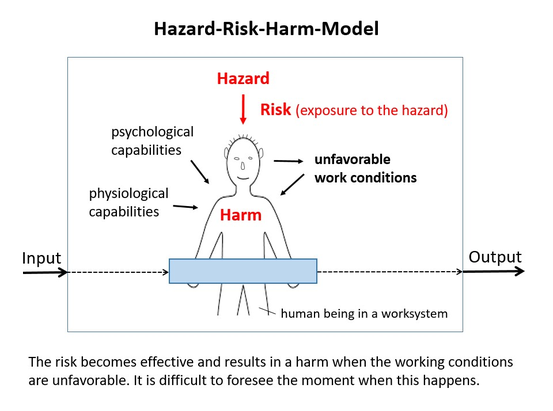
No risk should be overlooked. Therefore, both normal and abnormal "unfovorable working conditions" (when coincidences interact) must be examined. It is very difficult to predict exceptional working conditions that are "unfavorable".
How to reduce risks and avoid harms
To reduce risks and avoid harms it is necessary to do a risk assessment.
"Risk assessment is the process where you:
- Identify hazards and risk factors that have the potential to cause harm (hazard identification).
- Analyze and evaluate the risk associated with that hazard (risk analysis, and risk evaluation).
- Determine appropriate ways to eliminate the hazard, or control the risk when the hazard cannot be eliminated (risk control).
A risk assessment is a thorough look at your workplace to identify those things, situations, processes, etc. that may cause harm, particularly to people. After identification is made, you analyze and evaluate how likely and severe the risk is. When this determination is made, you can next, decide what measures should be in place to effectively eliminate or control the harm from happening." (www.ccohs.ca/oshanswers/hsprograms/risk_assessment.html, 01.05.21)
I use this form to do a risk assessment:
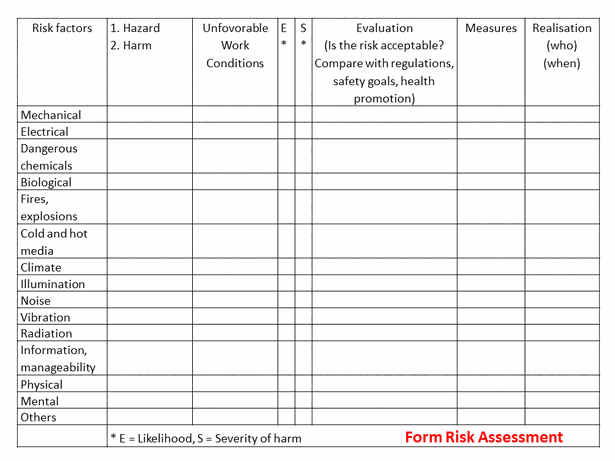
In order to know which risks are high and which measures are urgently required, a risk analysis and risk evaluation must be carried out. The risk analysis is done by answering the question "How likely is it that there will be a harm to health and how severe will this harm be?" (For more information, read the cited websites.)
After the risk was
estimated, the question arises: Is the risk acceptable or not? This question concerns the definition of the highest acceptable risk, the threshold risk.
An evaluation takes place by a comparison of the determined actual values with explicitly specified and justified limit values. These limit values can be inferred from laws, regulations or
recommendations or can be set (and justified) by the employer.
If the threshold risk is exceeded, measures must be accomplished for risk reduction. The actual risk must fall below the threshold risk as far as possible. But even then one will not reach a
condition without any risk, an element of risk remains.
Read "How to control a hazard" (www.ccohs.ca/oshanswers/hsprograms/hazard/hazard_control.html, 07.07.24).
Why do accidents and occupational diseases happen?
"Accidents at work and occupational diseases are neither determined by fate nor unavoidable – they always have causes. By building a strong prevention culture, these causes can be eliminated and work related accidents, harm and occupational diseases be prevented." (https://visionzero.global/sites/default/files/2017-12/2-Vision%20Zero%20Guide-Web.pdf, 09.07.21, p. 3)
Many accidents occur because people act the wrong way in dangerous situations.
An analysis of 228 fatal occupational accidents in the German chemical industry for the period 2004 - 2015 showed the following:
Were the accident leading to death and the associated risks easily predictable?
for the injured person: 66,2% yes or rather yes
for the executive/the entrepreneur: 54,8% yes or rather yes
Did the fatally injured person have a direct influence on the accident occurrence?
yes: 74,6%
no: 18,4%
no answer possible: 7%
(source https://www.bgrci.de/fileadmin/BGRCI/Downloads/BG_RCI_Magazin/BG-RCI_Magazin_2017/BG_RCI_magazin_web_15.5.17.pdf, 09.07.21, p. 5)
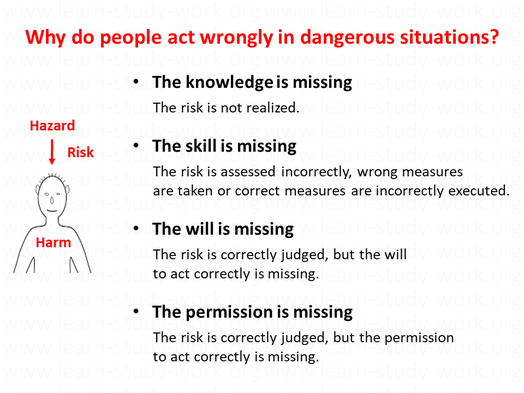
"Motivating your employees to act in a safe and healthy manner is one of your most important leadership responsibilities. ... When employees are consulted, for example while conducting the risk assessment or in the development of operating instructions, their willingness to follow the rules is improved. ... It costs nothing to praise employees for safe behaviour, ask them about their ideas, and express interest in difficult work tasks and also to address unsafe actions or near misses immediately. This can shape the personal attitude of the employees and motivate them to work safely and with awareness and above all, confidence." (https://visionzero.global/sites/default/files/2017-12/2-Vision%20Zero%20Guide-Web.pdf, 09.07.21, p. 18)
The attitude of people (and their motivation) depends on their personality and skills, on their knowledge and on their experiences and feelings (see the Attitude-Behavior-Success-Model on Learn-Study-Work).
